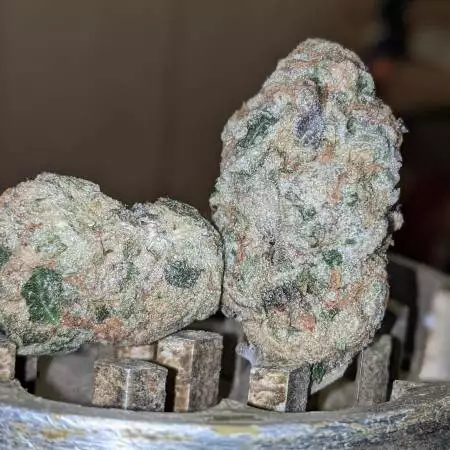The Grow Awards 2026 🏆 













Hello my name is Seth I'm 23 I'm from Ca...
Seth99_chronicbluntsstarted grow question 4y ago
Hello my name is Seth I'm 23 I'm from Canada Ontario and I've been growing for 5 years now I'm wondering if anyone can give me any tips and tricks for starting my grow this time around thanks you. I'd love to get in to indoor tho as well what do I need to get started my friends.
Open
Setup. Other
likes
Answer
NobodysBudsanswered grow question 4y ago
you'll need a room, tentn or similar that can effectively control length of night.
a powerful light that can amp up or otherwise be 150% stronger over 12 hours vs 18h during vege. 2 lights is often a good idea. it can save electricity and provide a lower seed-to-harvest cost. Electricty will be your single largest variable and ongoing cost. It is often worth it to invest a bit more up front in lighting and it will save you greater amount of money in the long run. warm white base diode will be 95% of the light. lm301's run at 0.25w per diode or at least <0.40w per diode using top bin. 3000k cct. some red/far red would drop the average cct lower and probably the minimum you want, but even just pure white diodes will do fine too.
Learn math of "DLI" (daily light integral)... ranges of ppfd you likely want to reach given ambient conditions, most importantly whether you add co2. you can work with this information to properly size the light you need for the area you intend to cover (i.e. indoor graden size). 800-900ish ppfd vs 1100-1200ish ppfd? allows you to compare apples to apples. you need 66% of the light over 18hours vs 12hours. it's difficult to have 1 light that does it all efficiently that doesn't skimp during most importnat phase - bloom. so, consider 2 lights for early and late. a seedling light as a cheap third option for first 2-3 weeks is also nice to have. extreme diming impacts integrity of the light's spectrum. it will deviate from the pretty curve they advertise at soem point. reference original manufacturer of driver and diode spec sheets, as it varies.
get something like jack's or maxigro? 2 or 3 part system that allows some adjustments to picky plants, but doesn't require "20" additional products to supplement it. soilless is probably the easiest, no frills way to grow. mix a 700-750ppm fert, water to 10% runoff (waste) and make small adjustments relative to VPD and other factors like genetics.
fertilier is cheap.. don't pay for name brand bullshit. e.g. there is no "class" of ammonium nitrate. it is always teh same molecule and always functions the same way. I spend less than /year on fertilizer. 0 == 4,667 gallons and 8lbs of cal nitrate leftover, lol.
Another area worth spending a few bucks more -- inline exhaust/intake fans, if oyu use a tent or otherwise need them. an "EC" motor gives greater control over power and more efficient with electricity. Terrabloom is an excellent option. i won't say the other name cause i'd rather eat dog shit than advertise for them. (fuck ac infinity, lol) but, if their hergometer control vs temp control of terrabloom is more useful, so be it. prices are comparable.. if you run it the same 24hours, go terrabloom. they are not dirtbags that push the ramifications of their own mistakes onto customers. obviously need some ducting. if they are selling stuff with black inerior, jump on it. it's the easiest path for a light leak into tent or room. I would always go larger than you need with exhaust/intake fans. Aim to run them at 50% or less and it'll be quieter and last longer. 4"ers can't do much unles you pair 2 up for a 4x4. probably has to run fairly hard for a 3x3 as an exhaust only. the benefit of intake+exhaust is you can adjust the presser... slight positve pressure will push walls out slightly as opposed to losing space from a negative pressure.. negative pressure will be better at containing smell , if that is an issue.
Carbon filters.. if they are cheap or don't list the amount of carbon used to fill the filter in grams.. you should be suspicious of quality. if no concern for smell, screw these overpriced things, lol.
easy to add automation if not going gung ho from the start. Can do dutch buckets or pure hydro with the same nutes. lots of options and kinda get your feet wet in several areas to see what you like best.
Maybe you don't mind your house smelling like poop? you can even go organic, bwahahah. chelated nutes and more frequent irrigations will realize greater rate of growth.
circulation fans
maybe, drainage pumps etc.. (6" raised platform with drainage to a condensate pump saves a lot of effort. or, simply a pump with a float switch that can also handle dirty water would be even better)
maybe, irrigation pumps etc.. doesn't need to be fancy to work well, but does need to be fancy to work well on a schedule with multple independent zones. at least some sort of drip manifold to easily callibrate flow to each pot.
can get fancy with a controller and pump relay switches... gives ability to irrigate remotely or automatically on a schedule. Larger the garden, the more automation recommended.
drain to waste is simple, can get similar to hydro results with a frequent irrigation setup and hedges risks by having a solid substrate. great starting point and even great place to stay.
likes
Complain
gottagrowsometimeanswered grow question 4y ago
Hey, I'll send you some1s info that I found very helpful and I'm sure they'ed be delighted to help u.
1 like
Complain
Similar Grow Questions
Solved

GhettoStyle
And if it's not difficult, tell me how I should control the light at all stages of growth from growth to the end of flowering!? at what distance from the plants should the light be? and what power adjustments on the driver should I make?
Other. Other
Setup. Lighting
Setup. Other
3y ago
3
2
Solved

BunnyBud
What are the right parameters for my setup?With a 60x52x104 cm grow box and one Spider Farmer SF1000D LED for 2 autoflowers, what is the optimal DLI for germination, vegetative, and flowering stages? What height should the light be? How to position plants and a 9-speed USB fan for ideal airflow and growth?Setup. Other
4mo ago
2
2
Solved

buddhi_coop
Gavita Light DimmerIs there a dimmer for the Gavita Pro 1700e LED grow light ?
Setup. Lighting
Setup. Seedling
Setup. Other
4y ago
2
2
Solved

Zeravlab
PPMNew to growing, and I am starting with DWC hydro. I am trying to setup my ph and ppm/ec. I bought a Yinmik YK-4. I am not sure what readings I am looking for, one place says seedlings need 400-500 ppm, another says not over 200 ppm. Current reading is 181 ppm & 341 ECSetup. Other
2y ago
4
Solved

alvitofr
Do I need to poke holes in this type of pot for seedlings?Hi, I was wondering if I could set my seed inside this pot without making holes in its bottom and sides since it was sold like this.
It is made of a cardboard-like paste and I don't know if it could help with drainage after watering my seedling during the first weeks.
Setup. Other
4y ago
2
2
Solved

Plenty420Gent
How do I "professionally" create a new hole/opening in my tent?My tents are perfectly arranged in my home.
But I need to cut a hole into my Secret Jardin DS120w,
to have more direct access, shorter cables and a functionally-descending gravity-fed nutrient-line.
How do I best cut a round 4-6 cm hole and add a proper lace-up closing to it?
3y ago
4
4
Solved

chasv77
LED Array Replacement Needed.To try and save some research time, I am trying to find an LED grow array to replace my current 240W Duo Drive.
240 Watts (48x5w) HID Eqiv =200w 10 band 17.25" x 7" x 3.25"
Physical size is important. Any "quick" answers for a 2'x2'x5.5' grow box?Setup. Other
6y ago
1
5
Solved

masdefs33
Incredibly low CO2 levelsAfter adding an A/C to my tent I began using bottled CO2 like never before. 20lbs in 5 days. Without adding, my CO2 is at 4 ppm. Yes, four parts per million in the dark. How can this be possible if the air in my house sits at 400ppm? I read that photosynthesis stops below 200ppmSetup. Other
2y ago
5
Solved

JSanchezz
Some general questions about Co2Is it Benificial if i Rise the the CO2 even if the Rest of the Conditions are the same Temp RH in W4 Flowering VPD ~1.3 ?
Co2 at the start of the day @1300ppm slowly decreasing to 500ppm at the end of the day
I think the plant uses as much Co2 as it needs if it has more availa
Setup. Other
2y ago
2
4














